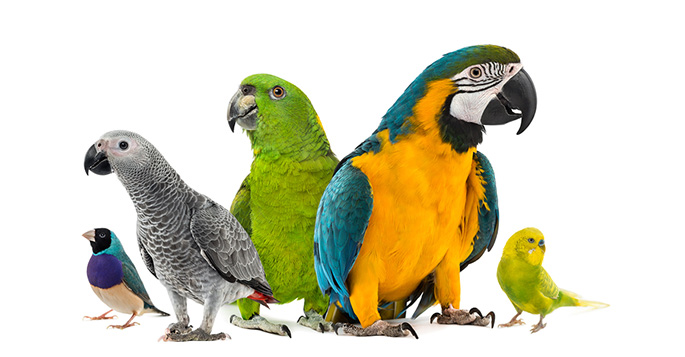Feather Plucking

Nail-biting, gum smacking, knuckle popping – they can be irritating habits people have. Even birds display their share of odd behaviors.
Feather plucking is a common habit among parrot-type birds, says Dr. Alice Blue-McLendon, a veterinarian with the Winnie Carter Wildlife Center at the Texas A&M College of Veterinary Medicine and Biomedical Sciences.
While most adult birds lose their feathers naturally once or twice a year in a process called molting, it is not natural for a bird to pluck out its own feathers, says Blue-McLendon. One of the clues that a bird is plucking its feathers is to look at the bird’s head. Since a parrot cannot pluck feathers from its own scalp, a feather-plucking bird will have a full head of feathers but be missing a lot of feathers on other parts of its body.
As simple as it may sound, the most common reason for a bird to pluck out its own feathers is boredom, says Blue-McLendon. “When a bird isn’t stimulated by its environment, it may begin plucking its feathers for entertainment or out of frustration,” she says.
Because of birds’ high intelligence level, environmental enrichment is extremely important for them, Blue-McLendon notes. They need plenty of toys to play with, especially ones they can chew.
“The more time they spend chewing on toys and food, the less time they have to chew on their feathers,” she adds.
Some birds enjoy playing with their own feathers after they have fallen out naturally through molting. Although feathers are cheap and simple toys, they aren’t appropriate ones.
Playing with loose feathers may spawn a nasty plucking habit. “You don’t want to encourage your bird to pluck its feathers out to have something to play with,” Blue-McLendon says. “Remove the feathers from the cage as soon as they fall out.”
Excessive grooming, or “preening” as it is known in the avian arena, is also not an appropriate pastime for birds.
“You should curb this behavior early,” says Blue-McLendon. “If you allow it to continue, some birds, especially cockatoos, can become overzealous in their preening.”
Preening can be another common precursor to feather plucking. Again, occupying its time with other activities can help rid your bird of its obsession with grooming, Blue-McLendon explains.
She says it’s important to try to break any bad habits as soon as you notice them.
“Temporarily changing your bird’s environment is a good start,” Blue-McLendon explains. “Try adding new toys to its cage or simply rearranging its existing toys. Also, consider moving its cage to another area of the house, possibly one with heavier traffic.”
If your bird’s meals consist of only seeds, try to incorporate new foods and flavors into its diet, says Blue-McLendon. Add colorful fruits and vegetables, especially those that can double as chew toys like celery, carrots, and green beans.
However, know that change is not always the best remedy. Sometimes variation, especially sudden and dramatic variation, in a bird’s environment can also lead to feather plucking, says Blue-McLendon.
Stressful events, such as moving, a death in the family or a reduction in time spent with its owner, can more than ruffle your bird’s feathers. They can cause anxiety-based behaviors like screaming and, of course, feather plucking. Be sure to make changes gradually and monitor your bird’s progress.
Also, before you make any changes, be sure your bird doesn’t have a medical reason for plucking its feathers such as mite infestation, a hormone imbalance or skin infection. These problems would warrant a visit to your veterinarian.
“Breaking a bad habit can be quite a feat,” Blue-McLendon adds. “But, if your mother could convince you to stop biting your nails, there’s a good chance you can help your bird eliminate its feather fixation.”
ABOUT PET TALK
Pet Talk is a service of the College of Veterinary Medicine & Biomedical Sciences, Texas A&M University. Stories can be viewed on the Web at vetmed.tamu.edu/news/pet-talk. Suggestions for future topics may be directed to editor@cvm.tamu.edu.


